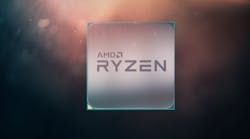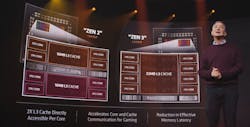AMD Rolls Out Desktop CPU Family With Zen 3 Architecture
AMD introduced its first family of desktop processors based on its new Zen 3 architecture, promising a significant uplift in performance as it challenges Intel's dominance in chips for personal computers.
The Santa Clara, California-based company said that the Ryzen 5000 series delivers a generational leap of 19% in instructions per cycle compared to its previous generation of personal computer chips. The chips also incorporate a redesigned core layout, larger cache of onboard memory, and faster clock speeds. AMD said improvements in the Zen 3 CPUs will result in an average of 25% more performance in gaming, while keeping power and core counts the same as Zen 2.
Despite the architectural overhaul, the company said it manufactured Zen 3 on the 7-nm process node from TSMC. That is the same generation of technology as the Zen 2 CPUs it introduced last year. Even though it is not upgrading the underlying technology node, AMD said that the Ryzen 5000 product line is 2.8 times more efficient than Intel's Core CPUs for the high-performance desktop market.
Lisa Su, AMD's chief executive officer, said that Zen 3 adds to its advantages over Intel in the market for PC chips, where it is gaining ground on its larger rival in performance and power efficiency. “Zen 3 increases our lead in overall performance," she said in a pre-recorded product launch for the Ryzen 5000 series. "It increases our lead in power efficiency, and now, it delivers the best single-threaded performance and gaming performance" compared to Intel's high-performance processors.
The Ryzen 5000 lineup promises up to 16 central processing cores clocked at from 3.4 GHz to 3.8 GHz and maximum speeds of 4.6 GHz to 4.9 GHz, according to AMD. The company crammed up to 72 MB of cache memory in the chips to store instructions that are used repeatedly by the CPU cores, wringing out more total performance. AMD said that the four processors in the product family would be on the market within a month and range in price from $299 to $799 for the flagship model.
For AMD, the Ryzen 5000 CPUs represent its latest challenge to Intel, long the global leader in the PC chip market. AMD has been rolling out new generations of chips with performance that can contend with or beats its larger rival's in industry benchmarks. AMD's market share in PC chips came to 19.2% in the second quarter of 2020, up from 11.1% in the same quarter of 2017, according to Mercury Research. Analysts see it grabbing even more market share in laptop and desktop CPUs.
AMD is also trying to take advantage of delays in Intel's development of chips based on the 10-nm node. AMD has been rolling out central processing chips at a scale of 7 nanometers manufactured by TSMC. But Intel has been hamstrung by delays in the production of 10-nm chips that are roughly as advanced as TSMC's. Intel, which has also been struggling with chip supply shortages, has been relying on its 14-nm process for its high-performance desktop processors since 2015.
“Our commitment with each generation of our Ryzen processors has been to build the best PC processors in the world," Saeid Moshkelani, senior vice president of the client compute business at AMD, said in a statement. "The new AMD Ryzen 5000 series desktop processors extend our leadership from IPC, power efficiency to single-core, multi-core performance and gaming."
At the heart of the improvements is the company's Zen 3 architecture. AMD said that it rearranged the layout of the central processing cores into clusters of eight cores each so that all the cores can directly access more of its onboard L3 cache. Zen 3 shortens the time it takes for these tiny cores to communicate with each other and cache crammed on the die, slashing latency. AMD said that it also doubled the total amount of L3 cache in Zen 3 compared to its previous Zen 2 architecture.
"There is the new layout of our processor that brings all the cores into a unified eight-core complex, and that accelerates core-to-core communication," AMD chief technology officer Mark Papermaster said in the virtual product launch.“That consolidation actually allows every core to directly access the 32 MB of L3 cache, and that directly accelerates workloads that are latency-sensitive.”
The Zen 2 architecture was based on a modular technology that divided the chip into smaller die called chiplets that can be reassembled in advanced IC packages. AMD's chiplet design separated the CPU cores, which are produced on TSMC's 7-nm node, and connected them to a central I/O die based on a 12-nm node via a high-speed die-to-die interconnect. Zen 2 is used in its Ryzen 3000 CPUs, which have higher core counts than Intel CPUs for use in personal computers.
With Zen 2, AMD assembled the central processing cores into groups of four cores each surrounding 16 MB of cache memory. Each CPU die on the chip incorporated two of these clusters, totaling eight cores and 32 MB of cache. The problem was that not all the cores could access the 32 MB of cache at the same time. To access the adjacent slice of cache, a core needed to get permission from the other cluster of cores. That increases overall latency, according to AMD.
AMD said that Zen 3 CPUs use the same type of chiplet architecture as Zen 2. The company said it doubled the number of cores packed on each compute die, giving every core unrestricted access to the full 32 MB of onboard cache. A larger pool of cache memory moves the data closer to the CPU cores on the die, reducing delays within the processor. "Every core can now communicate directly with the cache without traversing the die, and that reduces the latency," Papermaster said.
With the Zen 3 CPU architecture, AMD said the Ryzen 5000 series has the highest single-threaded performance of any desktop processor on the market, ideal for high-end personal computers used by gamers. The company said the flagship Ryzen 9 5950X, which integrates 16 CPU cores and 72 MB of cache, outperforms Intel's high-end Core i9-10900K, which has 10 cores and a top speed of 5.3 GHz.
AMD said the 12-core Ryzen 9 5900X desktop processor can run a range of popular games at an average of 7% faster than Intel’s processors in the high-performance desktop market.
AMD is also changing its pricing playbook. It is trying to leverage its performance lead to charge premium prices. Every chip in the Ryzen 5000 product line costs $50 more than its previous generation of processors. AMD said that there is a $799 starting price tag on the top-of-the-line processor, the Ryzen 9 5950X.
The company is also in the process of plotting out the Zen 4 architecture to be used in chips based on the 5-nm node from TSMC. Industry analysts said AMD could start selling those chips by 2022.
That could help keep it ahead of Intel, which has also delayed production of its 7-nm node and has pushed out its plans to start selling 7-nm chips for personal computers to late 2022 or early 2023.



